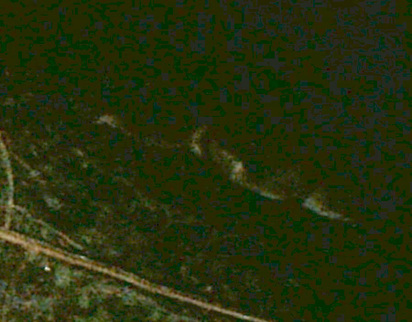
Some of the first trail cam pictures I ever got back from the field. This is a close up of an animal (cat/long tail) which was in one picture)
My big cat photo
analysis.
When I returned home I starting sequentially flicking through the
images I noticed that the first two
images caught a moving creature in the
background outside the flash zone
which appeared to have a long tail. Five hours later the next two images just
outside the flash zone showed a feline creature taking the bait with only some
parts of the creature catching the light of the flash. You could make out a positive cat like animal with a spotted leopard coat. I could not contain my excitement as between the two images the animal was clearly moving and taking the bait. I noticed most compellingly that the animal had clear black rings on the end of the tail a trait only indicative of Ocelots and leopards. The only way I could
defiantly determine what this animal was scale. Using a picture captured of me testing the camera position and a computer programme called AutoCAD the cat measured 135 centimetres from head to tail. The only other cat which could match the spotted coat of the cat caught in the image is a leopard cat or designer cats (hybrid of Asian and African wild cats) however the average length of these cats is only 43centimetres and don’t possess hollow rings on the tail. It has beenrecorded that leopard cats have been found dead on our roads in the past. However apopulation of these cats would probably become interbred over time with feral and domestic cats. The South American Ocelot is on average 120 centimetres from nose to tail so is quite fitting in regard to the cat in the image however not all Ocelots do have ringed tails and as is known within the big cat research community, small spotted cats are not always seen but black leopard like animals are. If Britain does have a population of black leopards there will still be spotted cats also. I will talk about this later. In the early nineties an ocelot was shot on the isle of white which shows there could be such a species present, also these animals were very valued in the pet trade and fur market which could have given
rise to a number of releases and possible inbreeding.
The leopard varies in size from 170 centimetres to 220 centimetres from nose to tail and can vary in size and weight quite considerably. It is rather large to fit the animal in the image but it could possibly be a young animal or even a relict smaller sized sub species population of British leopard that supposedly died out twelve thousand years ago.
My big cat photo
analysis.
When I returned home I starting sequentially flicking through the
images I noticed that the first two
images caught a moving creature in the
background outside the flash zone
which appeared to have a long tail. Five hours later the next two images just
outside the flash zone showed a feline creature taking the bait with only some
parts of the creature catching the light of the flash. You could make out a positive cat like animal with a spotted leopard coat. I could not contain my excitement as between the two images the animal was clearly moving and taking the bait. I noticed most compellingly that the animal had clear black rings on the end of the tail a trait only indicative of Ocelots and leopards. The only way I could
defiantly determine what this animal was scale. Using a picture captured of me testing the camera position and a computer programme called AutoCAD the cat measured 135 centimetres from head to tail. The only other cat which could match the spotted coat of the cat caught in the image is a leopard cat or designer cats (hybrid of Asian and African wild cats) however the average length of these cats is only 43centimetres and don’t possess hollow rings on the tail. It has beenrecorded that leopard cats have been found dead on our roads in the past. However apopulation of these cats would probably become interbred over time with feral and domestic cats. The South American Ocelot is on average 120 centimetres from nose to tail so is quite fitting in regard to the cat in the image however not all Ocelots do have ringed tails and as is known within the big cat research community, small spotted cats are not always seen but black leopard like animals are. If Britain does have a population of black leopards there will still be spotted cats also. I will talk about this later. In the early nineties an ocelot was shot on the isle of white which shows there could be such a species present, also these animals were very valued in the pet trade and fur market which could have given
rise to a number of releases and possible inbreeding.
The leopard varies in size from 170 centimetres to 220 centimetres from nose to tail and can vary in size and weight quite considerably. It is rather large to fit the animal in the image but it could possibly be a young animal or even a relict smaller sized sub species population of British leopard that supposedly died out twelve thousand years ago.

 RSS Feed
RSS Feed
